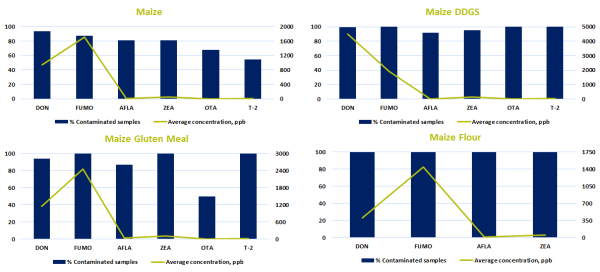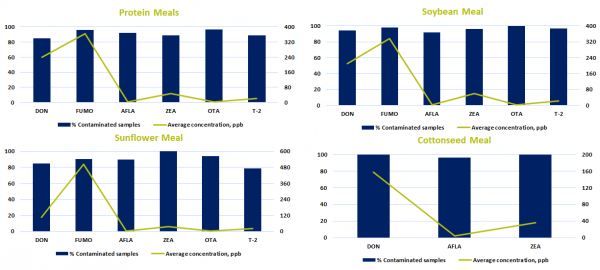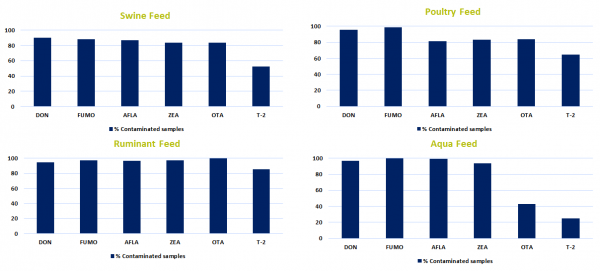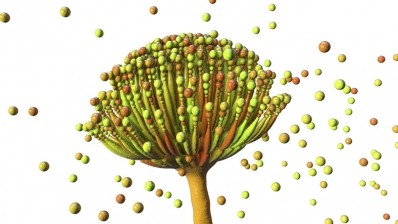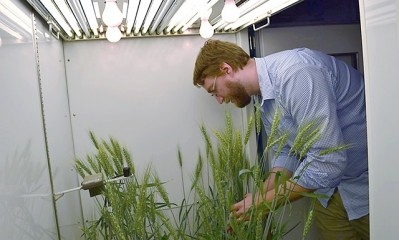Weather conditions impact on mycotoxin risk
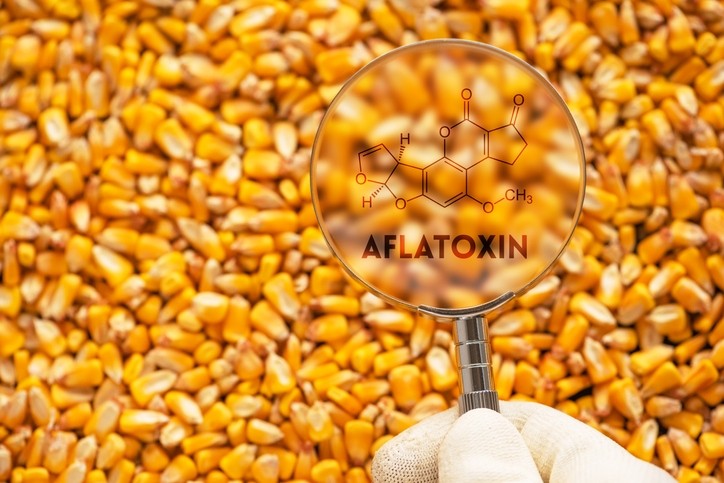
In the US, spring floods in the northern plains and Midwest delayed planting and harvesting of maize, allowing crops to stay in the fields longer and experience more mycotoxin exposure, according to the publication.
High temperatures from Texas to the Carolinas supported the increased synthesis of Aflatoxins (AFLA) and Fumonisin (FUMO) in US maize crops, while in In Europe, a heatwave led to poor soil moisture, compromising crop quality. Maize conditions, though, in China were generally favorable, as per the results of the risk analysis.
Turning to wheat, conditions in the Ukraine resulted in a mostly favorable crop, while excess moisture in Canada’s Eastern provinces delayed planting, noted the report.
Global mycotoxin landscape – prevalence and concentration levels influence risk
The prevalence and concentration levels of six common mycotoxins, Deoxynivalenol (DON), FUMO, AFLA, Zearalenone (ZEA), Ochratoxin A (OTA) andT-2/HT-2 toxin (T-2), s included in the company's risk analysis report.
Evaluating a composite of global crop samples collected in 2019, Trouw Nutrition said that more than 90% of samples had a quantifiable presence (>100 ppb) of DON, with between 80 and 90% of samples showing FUMO, AFLA, ZEA and OTA.
T-2 levels were lowest, at about 70%, it reported.
But the presence of a toxin does not paint an accurate picture of risk, said the company.
“A toxin’s concentration level, species type and duration of exposure should be considered. Even low levels of mycotoxins can present consequences for animal performance when these mycotoxins interact.
“Low levels of T2, OTA and AFLA can be toxic to pigs and poultry for example. Regulatory limits are another factor that must be addressed. For example, the regulatory threshold according to EFSA for AFLA is 5 ppb; and while average global samples were at 5.6 ppb, individual samples tested as high as 1,400 ppb for AFLA.”
Country of origin for the byproducts, protein meals, maize, silage samples, and complete feeds that were tested
Source: 2019 global mycotoxin risk analysis report by Trouw Nutrition
Maize, DDGS sample findings
The company said its 2019 mycotoxin report includes analysis for individual ingredients, complete feeds and silages, including small grains - wheat and barley, which tested at as high as 88% for DON, to 59% for AFLA. Among byproducts, concentrations in DDGS were significantly higher than in maize, with levels approaching 5,000 ppb.
Protein meal sample findings
Looking at protein meals, concentrations of mycotoxins were relatively low compared to cereal grains, it said.
“However, soybean meal is used at about 25-30% of monogastric diets, and hence can contribute significantly to concentration of toxins in final feed. Sunflower meal showed the greatest concentration of FUMO while levels of DON, AFLA and ZEA were lower. “
Maize and grass silage sample findings
Among silages, 100% of maize and grass silage samples showed mycotoxin contamination with concentrations that can cause toxicity in ruminant animals, found the report.
Pig, poultry and ruminant complete feeds and toxicity risk
Looking at complete feeds including pig, poultry, ruminant and aquaculture, around 84% of samples showed contamination, reported Trouw Nutrition.
Evaluating pig feed, samples were found to contain DON at 623 ppb, FUMO at 1662 ppb and ZEA at 52 ppb – a level that may present a synergistic toxicity threat to pigs, said the company.
In poultry feed, DON and FUMO present the greatest risk at 985 ppb and 2,110 ppb respectively, it said.
“Taken together, these levels can impose a challenge on the bird’s immune system and may also exert a negative effect on the feed conversion ratio.”
Global ruminant samples find DON with an average concentration of 1,100 ppb and ZEA with 53 ppb, which can compromise health and performance of dairy cows, noted Trouw Nutrition.
“On the other hand, AFLA at 5.6 ppb can make it challenging to keep the aflatoxin M1 level in milk below the EU’s regulation of 0.05ppb.”
Evaluating risk around the globe
Crop growing conditions, species of animals raised, and the raw materials used in feeds vary around the globe, said the company.
Having analysed common mycotoxins across the regions of South/Central America, Europe, Asia, Middle East/Africa, and North America, it determined that DON, FUMO, ZEA, and AFLA contamination was quite similar across the regions except for North America where AFLA had low risk. T-2 toxin and OTA contamination levels were quite different across regions, it said.
In South and Central America, high levels of DON, FUMO and ZEA pose a synergistic threat, said the company.
Asia’s primary mycotoxin threat is FUMO and AFLA; but while Asia’s DON levels pose a challenge for swine, they do not present a risk for poultry, it added.
In North America (Canada), DON and ZEA are key toxins, it said.
In the Middle East/Africa region, DON, AFLA and ZEA are primary mycotoxins and DON and ZEA are the most prevalent mycotoxins in Europe, reported Trouw Nutrition.
A look at preliminary 2020 Q1 Data
An analysis of samples collected and analyzed by its Mycomaster between January and March 2020 suggests mycotoxin contamination levels are slightly lower than in 2019, but it is too early to get a full picture, cautioned Trouw Nutrition.
Average concentration levels of DON were 557 ppb; clearly toxic to pigs. AFLA concentrations were 7.8 ppb, above the EU threshold of 5 ppb, it said.
“The preliminary data suggests high toxicity to pigs, moderate toxicity to ruminants and low toxicity to poultry.”
Dr Swamy Haladi, Trouw Nutrition’s global program manager for mycotoxin risk management, commented: “While the biological susceptibility of crops and environmental conditions cannot be controlled, understanding the presence, concentrations and physiological risks various mycotoxins present to each species through our extensive global database can help farmers manage mycotoxin risk effectively.”
